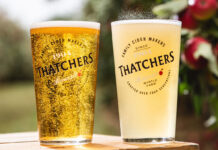Adrian Gomes, The Tippling House, Aberdeen
 How important are craft spirits to your bar?
How important are craft spirits to your bar?
Hand-crafted and boutique spirits are very important to the drinks offering at The Tippling House as our guests look to us to offer them something they can’t find in most other bars. Working with new local brands, as well as niche international brands, helps create a point of difference.
Are there any spirits categories where you can see a particular rise in the number of craft products?
The most obvious category is gin, but outwith this, I think mezcal has provided us with some very interesting releases, including the Derrumbes mezcal range, which joins Del Maguey in providing some very interesting village and region-specific flavour profiles.
What trends do you expect to see in the craft spirits sector this year?
Possibly some of the first releases of true small-batch whisky from the gin producers who started to lay this down five to ten years ago. I’m interested to see how these turn out, given that some of the global whisky brands we all know and love today have had a 250–300 year head start of fine tuning their liquid.
How are most craft spirits sold in your bar?
In cocktails; one in two drinks sold in The Tippling House is a cocktail. We have 15 seasonal drinks on our menu at any given time, changing three to four times per year, so we can be quite experimental when trying out new products or limited releases.
What tips would you give an operator looking to expand their craft spirits range?
It takes good salesmanship to go with a range that requires you to suggest alternatives to mainstream brands.
Make sure to give your team the information and confidence needed to hand-sell a brand.
Sebastian Stanczyk, The Spiritualist, Glasgow


Craft spirits are like a distiller’s handshake to us, we appreciate the time that has been spent carefully creating truly artisan liquid with its own personality. It is important to us to share what we think deserves attention. As ambassadors of many spirits we treat craft as another step forward to meet our guests’ desires as well as unveil unexplored lands.
What trends do you expect to see in the craft spirits sector this year?
I believe that we might see more rules explaining what it takes to call a spirit ‘craft’. Another year is still not enough time to appease the comeback of the ‘gin craze’, nevertheless I’m very optimistic that more craft vodka will make its way onto bar shelves soon as it is deserved and I’ve always been rooting for it.
How are most craft spirits sold in your bar?
If we look closely at certain periods of the week, I can easily tell that during weekdays we have enough time to encourage our guests to try a spirit neat. After making an opinion on what a distiller wants to share with us, we take our customers for a journey as we like shaking things up. Realistically long drinks are the most efficient way of introducing a craft spirit during the weekend when it’s busy.
What tips would you give an operator looking to expand their craft spirits range?
It is vital for an operator to empower their team with the knowledge to be able to sell the product and for the distiller to support this with training. These relationships are key to the growth of the industry as a whole.
What is your favourite craft spirit and why?
It’s hard to choose one but I’d pick Vestal vodka.
It’s straight from my homeland, packed with flavour due to only one distillation, made with potatoes planted with care that winemakers would appreciate and they’re foraged early as this gives the most flavour. This brand stays strongly behind the original Polish flavour.
It can be drunk neat, appreciated and enjoyed.
Dale Murray, Bird and Bear, Dundee


At our bar we tend to keep things nice and fresh, whether it be with new trends of drinking, new craft spirits all the way down to our craft beers, we like to give our customers something different and I feel that craft spirits is the way forward in making these things important in a bar, from their back story or the way they are distilled.
Are there any spirits categories where you can see a particular rise in the number of craft products?
We’ve already seen this over the years, but I think gin will continue to spearhead this. Gin is so diverse in the sense that you have a vast amount of botanicals at your disposal to choose from and allow anyone producing the spirit to make something really different and unique.
What trends do you expect to see in the craft spirits sector this year?
I expect to see a larger bitters influence reemerging once again. This will provide customers with more information about the more classical aspects of drinks, that would be leaning towards a bitter taste from spirits like Campari, vermouths and amaro.
What tips would you give an operator looking to expand their craft spirits range?
My favourite thing about new craft spirits, which I love, is the story behind the creation of the spirit, how it is distilled, what it is distilled with, why did they choose the ingredients they did or how they decided upon the name of the product. If I can get hooked on the reasoning of their love and passion of making the products then that pushes me more to want to spread that passion in selling the product.
What is your favourite craft spirit and why?
I couldn’t put my finger on one craft spirit that’s my favourite. I’ll read up on one spirit and will be intrigued and then something else will catch my eye the next week. Surprisingly I don’t drink too much gin but I’m usually swayed towards them as my favourite spirit to try and upsell. The two I usually have a preference for are Porter’s Gin from Aberdeen or the London dry Jindea. I’m a little biased in saying that I tend to push these brands more as I know the people behind them, but I wouldn’t recommend them to customers unless I thought they were something different, or one of the top spirits in their category.
























